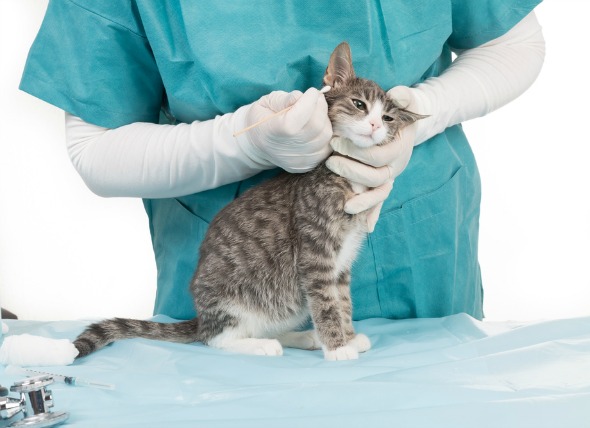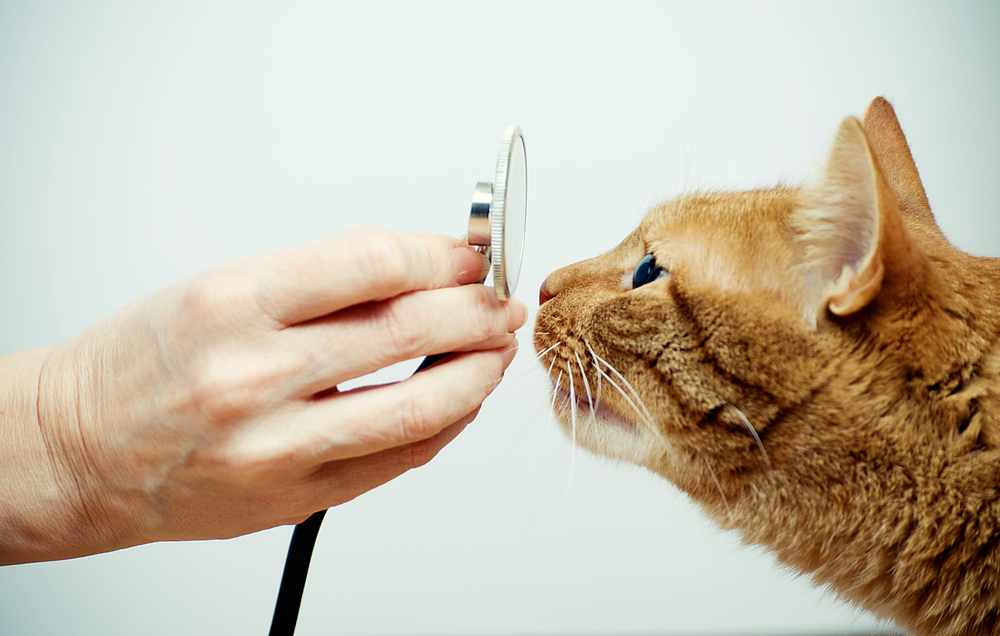

Otodectes cynotis mites, most commonly called ear mites, are a common and relatively mild external parasite infection. Complications may arise when an animal has an immune hypersensitivity reaction that results in intense irritation of the external ear.
Cats that are afflicted with ear mites will typically scratch at the ears excessively and shake their heads, even pulling out their own hair and drawing blood as they scratch. Some cats will shake their heads so much that an hematoma of the ear will form (with blood pooling in the ear due to breakage of a blood vessel). Also of concern is when cats scratch at their ears to the point that injury is done to the ear canals or ear drums.
This type of mange is common in young cats, although it may occur at any age. It is known for being highly contagious, frequently passing from parent to newborn, and between animals of different species (this mite does not affect humans). The mite also commonly spreads out to other parts of the body.
You will need to give your veterinarian a thorough history of your cat's health and onset of symptoms, as well as whether your cat has regular contact with other animals or spends time outdoors. Your veterinarian will perform a complete physical exam on your cat, including standard lab tests, such as a chemical blood profile, a complete blood count, a urinalysis and an electrolyte panel, to be sure that your cat does not have any other diseases.
A thorough dermatologic exam will be performed, with skin scrapings taken for laboratory analysis. Ear swabs may be placed in mineral oil to identify the mites, and your veterinarian can use an otoscope to look into the ear canals, where ear mites can be visually discovered directly in the ear. If your cat is hypersensitive as a result of the infestation, making a deep examination of the ears difficult, a diagnosis may be made by your cat's response to medical treatment.
Patients can be treated on an outpatient basis with medication designed to eradicate the mites. As this infection is very contagious, all animals in the same household should be treated and the environment cleaned very thoroughly. Mites do not survive long away from the animal's body, so a thorough house cleaning should be enough.
Your cat's ears will need to be thoroughly cleaned. A commercial ear cleaner that is designed specifically for cats can be used to gently clean out any debris before beginning topical treatment on the ears. Ear mite parasiticides should be used for 7–10 days to eradicate mites and eggs, and flea treatments should be applied to the cat for elimination of ectopic mites. Because cats sleep with their tails curled up close to their heads, be sure to clean the tail thoroughly as well.
The prognosis is good for most patients. One month after therapy begins, your veterinarian will schedule a follow-up appointment to swab your cat's ears and to perform a basic physical exam.
 Diarrhea (Long-term) in Cats
Chronic Diarrhea in Cats
Feline chronic diarrhea
Diarrhea (Long-term) in Cats
Chronic Diarrhea in Cats
Feline chronic diarrhea
 Lack of Bladder Control in Cats
Urinary Incontinence in Cats
Problems with the bl
Lack of Bladder Control in Cats
Urinary Incontinence in Cats
Problems with the bl
 Droopy Eye in Cats
Horner’s Syndrome in Cats
Conditions of the
Droopy Eye in Cats
Horner’s Syndrome in Cats
Conditions of the
 The Consequences of Feeding Wild Cats
The Consequences of Feeding Wild Cats
The Consequences of Feeding Wild Cats
The Consequences of Feeding Wild Cats
 Ear Cancer in Cats
Auricular Squamous Cell Carcinoma in Cats
Cats ca
Ear Cancer in Cats
Auricular Squamous Cell Carcinoma in Cats
Cats ca
Copyright © 2005-2016 Pet Information All Rights Reserved
Contact us: www162date@outlook.com